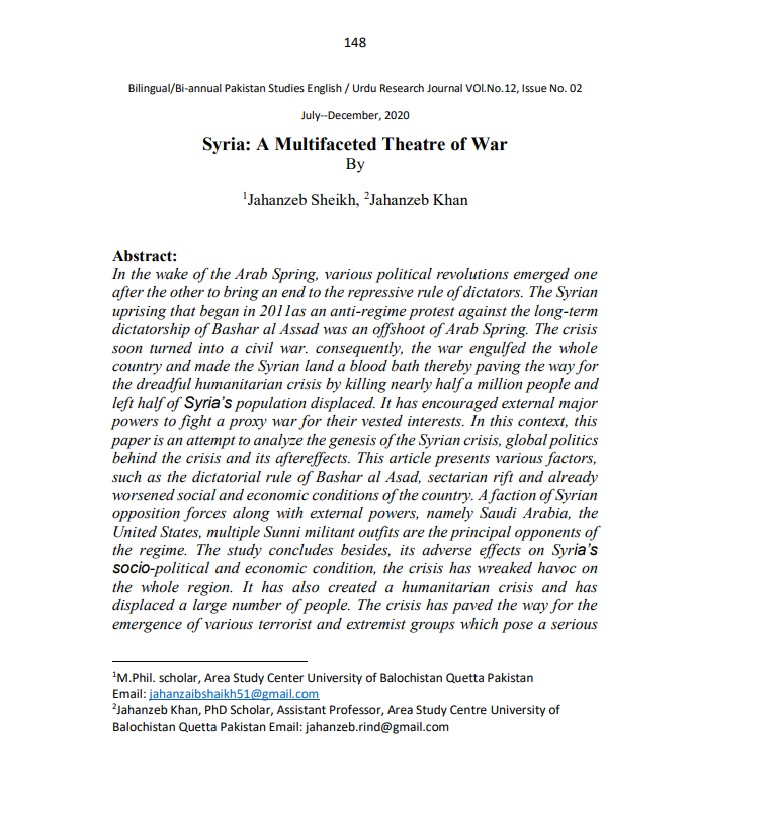Syria: A Multifaceted Theatre of War
Keywords:
Arab Spring, Syria, Bath Party, Bashar-ul-Assad, Foreign alliances, Regional powers, etc.Abstract
Abstract:
In the wake of the Arab Spring, various political revolutions emerged one
after the other to bring an end to the repressive rule of dictators. The Syrian
uprising that began in 2011as an anti-regime protest against the long-term
dictatorship of Bashar al Assad was an offshoot of Arab Spring. The crisis
soon turned into a civil war. consequently, the war engulfed the whole
country and made the Syrian land a blood bath thereby paving the way for
the dreadful humanitarian crisis by killing nearly half a million people and
left half of Syria’s population displaced. It has encouraged external major
powers to fight a proxy war for their vested interests. In this context, this
paper is an attempt to analyze the genesis of the Syrian crisis, global politics
behind the crisis and its aftereffects. This article presents various factors,
such as the dictatorial rule of Bashar al Asad, sectarian rift and already
worsened social and economic conditions of the country. A faction of Syrian
opposition forces along with external powers, namely Saudi Arabia, the
United States, multiple Sunni militant outfits are the principal opponents of
the regime. The study concludes besides, its adverse effects on Syria’s
socio-political and economic condition, the crisis has wreaked havoc on
the whole region. It has also created a humanitarian crisis and has
displaced a large number of people. The crisis has paved the way for the
emergence of various terrorist and extremist groups which pose a serious
1M.Phil. scholar, Area Study Center University of Balochistan Quetta Pakistan
Email: jahanzaibshaikh51@gmail.com
2
Jahanzeb Khan, PhD Scholar, Assistant Professor, Area Study Centre University of
Balochistan Quetta Pakistan Email: jahanzeb.rind@gmail.com 149
threat to the political stability and territorial integrity of Syria and regions
beyond.
References
References:
A. Vatanka. (2017). Iran and Russia, Growing Apart: Rising over the
IRGC's. Foreign affairs.
Akram, M. (21 Nov 2019). Dawn News. Calabrese, J. (2012). The Regional
Implications of the Syrian crisis. Middle East Institute.
Dincer, O. (2011). The Role of the United States in the Middle East.
International Strategic Research Organization.
Filkins, D. (2018). A Saudi Prince's Quest to Remake the Middle East.
Newyork: The New Yorker.
G.P.J, D. (2017, November 13). A Peace Bottom-up Approach, Linking
reconstruction assistance to local government formation. Retrieved
from Rand Corporation:
https://www.rand.org/pubs/perspectives/PE276.html.
Haddad, B. (2011). The Political Economy of Syria Realities and
Challenges. Middle East policy, Volume 18.
Jalen, T. (2013). The Syrian Civil War and its Implication. Mediterranean
Quarterly Volume 24.
Lanblack. (2016). Report on Syrian Conflict. The Guardian.
Lusi Roger, D. G. (2015). Conflict Background. BBC News.
M.Eddy. (2012). Syrian Group Envisions Transition from Assad. The New
York Times.
Marc, L. (2012). The Arab Uprising. The Unfinished Revolution of the New
Middle East.159
Mchugh, J. (2013). Causes of Syrian Civil War 2011. World Watch
Monitor.
Sajedi, A. (2013). The Syrian Crisis and the intervention of foreign Powers.
Research letter of International Relations 6, 24.
Seal, P. (1989). Asad, the Struggle for the Middle East. California:
University of California Press.
UNESCO. (2016). Syria's six UNESCO World Heritage Sites all damaged
or destroyed. independent.
Vpharan. (2016). Roots of Syrian Crisis. IPCS.
Youssef, C. (2007). Post-Colonial Syria and Lebanon: The Decline of Arab
Nationalism and the triumph of the State. London: I.B Tauris



